Halong Bay Travel Guide 2023: Unveiling Vietnam’s Stunning Gem
Vietnam is naturally gifted with a wide range of splendid and unique landscapes, from majestic mountains to picturesque beaches. This wonderful advantage has contributed to beautiful tourist attractions throughout the nation. When it comes to Vietnam tourism, Halong Bay is undoubtedly one of the most well-known destinations that every foreign traveller must visit for a complete trip in the S-shaped country. Numerous pieces of information about Halong Bay travel can be found on the Internet, which sometimes may make first-time tourists overwhelmed and confused. This comprehensive guide will provide you with fundamental knowledge on Halong Bay Vietnam so that you can well prepare for your upcoming journey.
Overview of Halong Bay Vietnam
Where is Halong Bay Vietnam
Halong Bay is located on the Western side of the Gulf of Tonkin (the Northeast of Vietnam), surrounded by Bai Tu Long Bay to the East and Lan Ha Bay to the South. On the adjacent coast to the North of the bay lies Halong City. It takes about 2.5-3 hours to travel from Hanoi City Center to Halong Bay through a 155km route.
Halong Bay covers an area of 43,400 ha and comprises over 1600 islands and islets in numerous sizes and shapes. The outstanding highlight of this property is being centered around the drowned limestone karst landforms, displaying majestic pillars with various arches and caves which form magnificent natural scenery. The limestone in Halong Bay has gone through 500-million-year geological processes under different conditions and environments to form unique karst landscapes found today.
The bay is also the home to a diverse ecosystem of flora and fauna. There are about 1,000 species of marine creatures, among which 160 species of coral have been identified at a depth of 4-6 meters.
Thanks to its exquisite seascapes and significant geographical and biological values, Halong Bay was recognized as a UNESCO World Natural Heritage twice in 1994 and 2000 and was voted as one of the New Seven Wonders of Nature in 2011.
Attractions in Halong Bay Vietnam
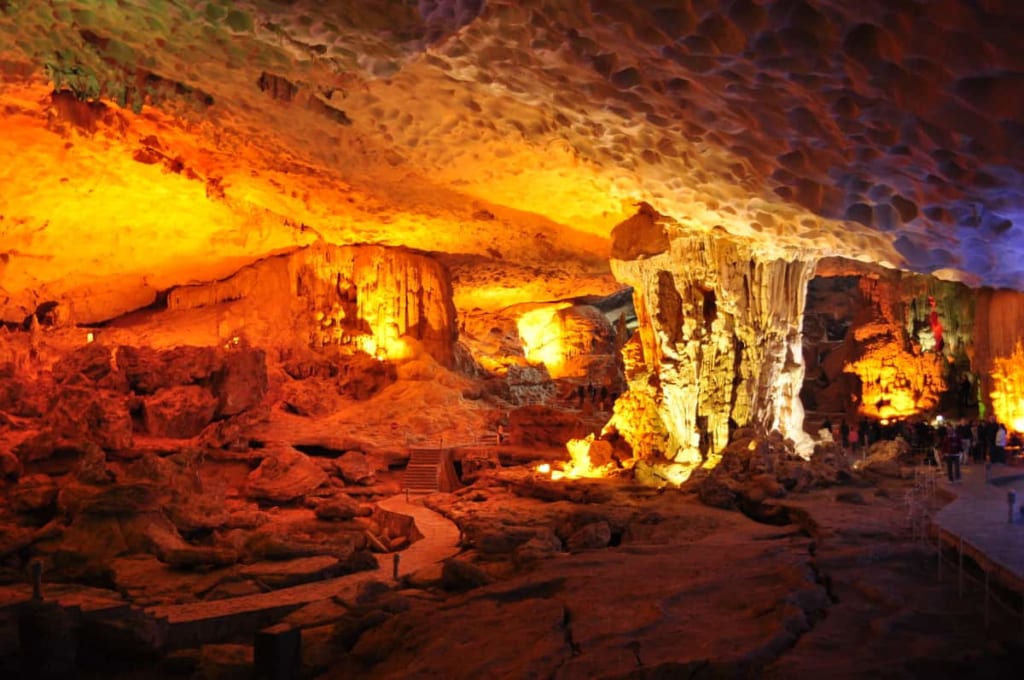
Sung Sot Cave
The largest and most magnificent cave in the bay featuring marvelous and mysterious thousand-year-old stalactites in a variety of unique forms.
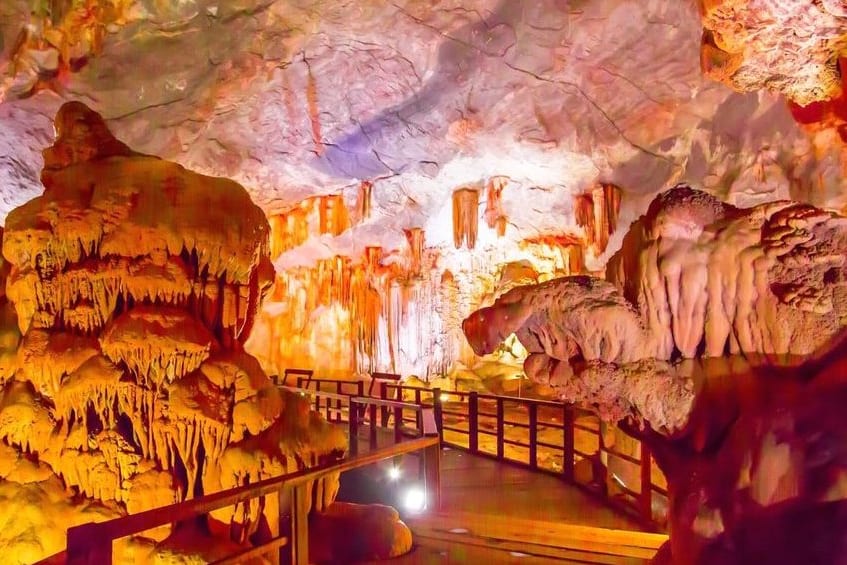
Thien Cung Cave
The most interesting and legend-filled cave with three large chambers and a complex interior structure offering in-depth adventures.
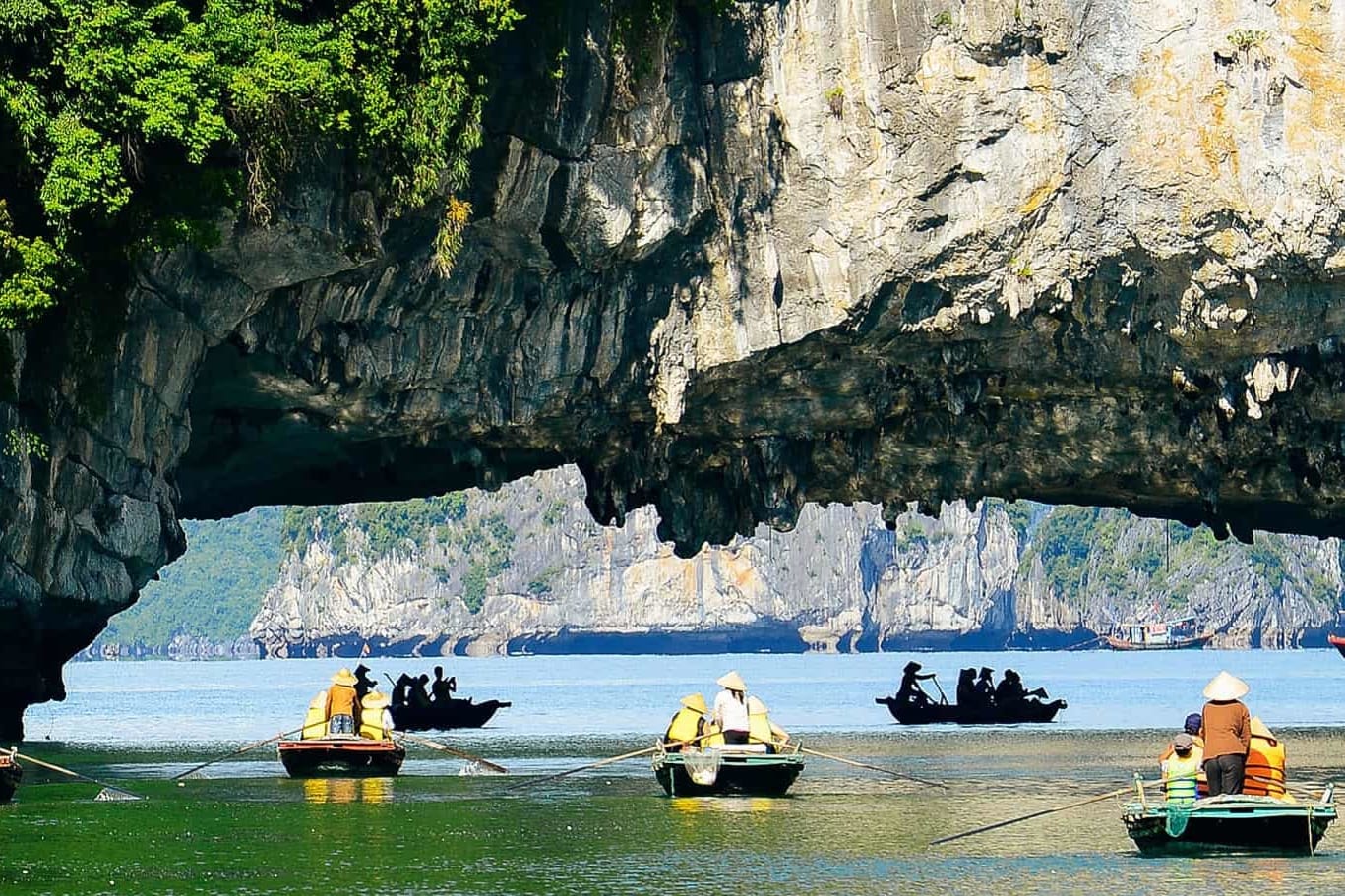
Luon Cave
A unique cave including a self-contained lake inside a closed arch-shaped mountain, along with a magnificent interior featuring sparkling and eye-catching stalactites.
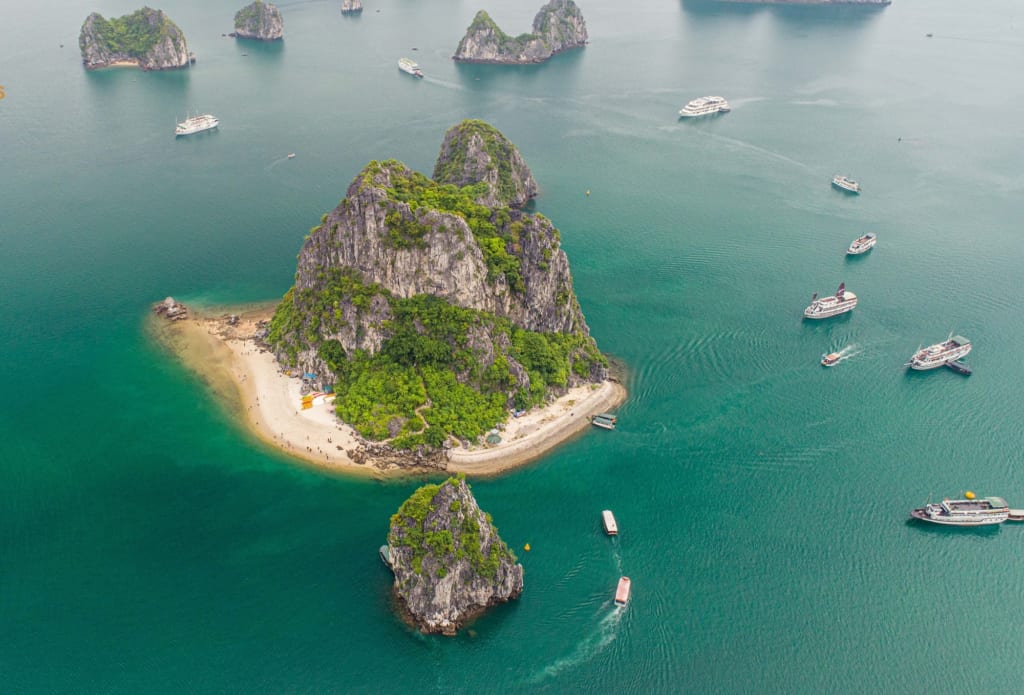
Titov Island
A splendid destination encompassing a crescent moon-shaped beach and a 110m mountain with a breathtaking 360-degree view of the Bay.

Me Cung Cave
The cave encompasses big stone pillars formed by the development of thousand-year-old stalactites and stalagmites and fossils of freshwater animal bones.
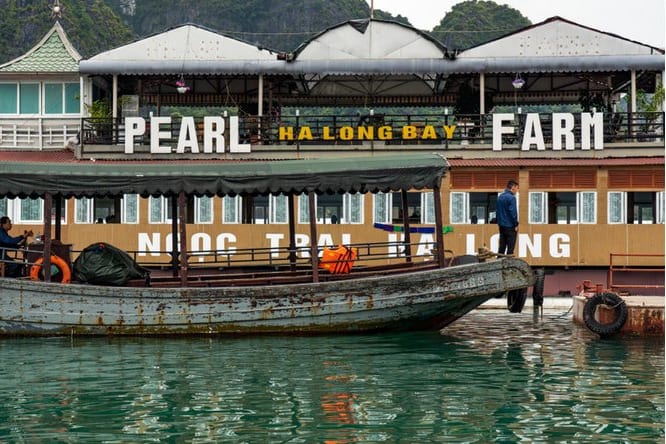
Tung Sau Pearl Village
An area in Halong Bay dedicated to growing pearls and practicing a handmade technique based on Vietnamese tradition and Japanese technology.
Halong Bay Vietnam Weather
Overview
Located in Northern Vietnam, Halong Bay weather is characterized by a typical humid and tropical monsoon climate, consisting of four distinctive seasons throughout the year: Spring, Summer, Autumn, and Winter.
Springtime in Halong Bay usually lasts from February to possibly mid-April with an average temperature of 18 to 27°C and insignificant rainfall.
Summer lasts from May to August, featuring overheat weather, high humidity level, and heavy rainy days. The daytime sees an average temperature of approximately 34-35°C, clear and blue sky, and longer duration. July and August are the wettest months of the year with heavy rains and sporadic hurricanes.
Autumn lasts from September to October, characterized by enjoyable weather: cool, dry, and mildly sunny, with the average temperature fluctuating between 23 and 27°C. Late October may see Northeastern monsoons featuring some cold days.
Halong Bay’s winter lasts from December to January, featuring cold and dry weather and a low average temperature of 12-23°C. In this season, the nighttime is often longer than the daytime. Rain occurs sporadically in form of drizzle.
The best time to visit Halong Bay Vietnam
In each season, Halong Bay is alluring and gorgeous with different attractiveness, making the Heritage worthy of all-year travel. Based on personal interests, tourists can select the most favorite time for a Halong Bay vacation. If you desire to enjoy outdoor activities absolutely, autumn (September – October) and spring (February – April) are most recommended thanks to such pleasant weather. For those who prefer the heat, sunshine, and swimming, summer is ideal, but you should consider the peak season in the early summer as well as the storm period between July and August.
- For cruising: February, March, April, September, and October
- For sightseeing trips: All year (except for late July and August)
- For water-based activities: April, May, June, September, and October
- For money saving: July, August
Best things to do in Halong Bay Vietnam
Thanks to a diversity of naturally gifted landscapes, from islets, islands, and beaches to limestone caves, travellers can discover the bay in different wonderful experiences. Here are 15 suggestions for must-try activities in Halong Bay that you can add to your bucket list for a remarkable trip.
Taking a Halong Bay Cruise
Cruising is regarded as the best way to admire the charming Heritage and travellers’ leading choice for a bay adventure. Not only take visitors across stunning landscapes, cruises also offer all-inclusive packages of itinerary, transportation, accommodation, cuisine, entertainment, etc. There are a wide range of onboard recreations such as Sundown pool party, Night squid fishing, Vietnamese cooking class, or Sunbathing on the sundeck.
Halong Bay Sightseeing
Explore majestic caves in Halong Bay
Cave exploration is a must-try activity when visiting Halong Bay. The Heritage is home to a variety of marvelous caves which definitely impress travellers at the first sight. Thanks to the formation of stalactites and stalagmites over thousands of years, Halong caves feature such unique exquisiteness and valuable archaeological systems.
Discover Titov Island
Titov Island attracts nature-lovers thanks to its one-of-a-kind and picturesque landscapes. Immerse yourself in the refreshing turquoise seawater, relax and have a sunbath on the white sand beach, or climb up to the mountain peak and admire the breathtaking majesty of the bay.
Visit Halong Floating Villages
Floating villages are among the top Halong Bay attractions for tourists’ fascinating and genuine experiences. Coming there, you will a chance to meet local people and learn more about their daily lives as well as work tasks.
Take a Halong Bay seaplane tour
There is no better way to behold the natural magnificence than from the height of 300 meters on the seaplane. Flying over the stunning karst formations and emerald water, you will treat your eyes to a 360-degree sublime overview of Halong Bay.
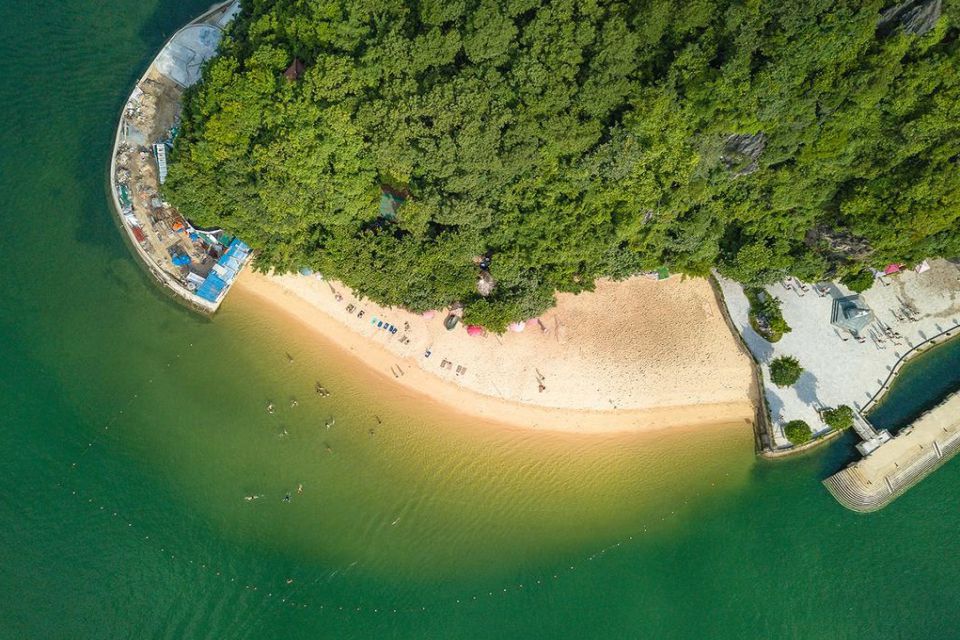
Water-based activities in Halong Bay Vietnam
Swimming
Halong Bay is blessed with a calm sea and splendid beaches surrounded by limestone islands, which are ideal to sit back on the white sand, enjoy the refreshing atmosphere, and indulge in crystal-clear water.
Kayaking
Kayaking is one of the most fantastic things to do on your Halong Bay excursion. This is no doubt the best way to discover the beautiful charms of the New Natural Wonder’s nature at a close distance. Sit on a small kayak, paddle slowly through grand islets to explore cliffs beneath the waves, feel the calm water, wriggle into water caves, or touch stalactites. With specific instructions about how to paddle and guide on the safe area, you will take delight in fun and amazing experiences.
Diving/Snorkeling
Scuba diving and snorkeling are both the greatest ways to enjoy the ultimate peace and explore the stupendous marine life in Halong Bay. Tourists are suggested to scuba dive or snorkel from May to September (except for late July and August due to the rainy season).

Things to do in Halong Bay other than cruise
Rock Climbing
Encompassing over 1,600 limestone karst islands featuring steep walls emerging directly from the sea surface, Halong Bay is one of the best rock climbing destinations. There are well-bolted crags in the bay that are perfect for this adventurous activity: Butterfly Valley, Hidden Valley. It is thrilling but exciting to behold a magnificent overview of the bay from the height.
BBQ Party on the beach
Halong Bay is naturally gifted with a wide range of seafood and calm beaches, which cannot be better for a beach barbeque with baked king prawns, squid, crab, lobster, etc. There are various choices of beach BBQ in Halong, from restaurants along the coast to an overnight cruise itinerary.
Discovery of Halong on land
If Halong Bay features a serene and pristine exquisiteness, Halong City can be described as vibrant and dynamic with an array of exciting entertainment choices. Enjoy seafood at local restaurants, taste Halong’s specialties or street food, indulge in nightlife activities, visit night markets, or experience thrilling and fun games at Sun World Halong Park, etc.

Halong Bay Vietnam Cuisine
Halong Bay fascinates global tourists with not only its marvelous and unique natural beauty but also its exceptional local cuisine. From the quintessence of fresh seafood to special street food, each option brings irresistibly delicious flavors which definitely make your mouth water.
Halong Bay fresh seafood
There is a wide range of marine specialties in Halong such as squid, prawn, crab, seashell, snail, and so on. The seafood will be cooked in various ways, from being steamed, grilled, fried to salad or soup, combined with a lot of ingredients and spices, offering travellers diverse and changed tastes. In Halong Bay, you can enjoy seafood at a restaurant, on a luxury cruise, or even at some street vendors.
Halong grilled chopped squid (Cha muc)
This dish can be regarded as “The symbol of Halong” and was also voted as one of Vietnam’s tastiest dishes by Asian Record. Although you can eat Grilled Chopped Squid in some other places, the flavor of Halong’s version seems to be more distinctive.
The specialty is made from chopped or minced fresh squid, floured, and deep-fried. Despite its relatively simple recipe, Cha Muc Halong features an excellent taste and irresistible smell. The kind of squid selected for Grilled Chopped Squid is “Muc Mai”, a special and exclusive squid in Ha Long Bay. Besides the principal ingredient, other spices such as dill, black pepper, fish sauce, etc. are also added in order to bring out the signature flavor of Cha Muc. Halong people usually enjoy Grilled chopped squid with Vietnamese steamed rice rolls (banh cuon) or sticky rice (xoi) and sweet and sour dipping fish sauce.

Tien Yen Hill chicken
The best Halong Bay food includes not only seafood-related options but also land-based ones, namely Tien Yen Hill chicken. Tien Yen is a small town in Quang Ninh Province (70km far from Halong City), where chickens are raised in a natural way. Specifically, they are free to run on hills and find food in nature without any cage. This special breeding method may mainly account for the exceptionally delicious chicken meat that is firm, buttery, and sweet. Tien Yen Hill chicken can be processed in a variety of recipes, but the most preferred dish is boiled chicken. In this way, the natural flavors of chicken meat can be maintained.
Nodding Cake (Banh Gat Gu)
When it comes to famous Halong Bay street food, Nodding Cake (or Banh Gat Gu) is the top-list recommendation. Originated in Tien Yen Town, Quang Ninh Province, this dish is sophisticatedly hand-made from selective rice powder and served hot with special fish sauce cooked with minced pork, fried onion, and chicken fat. Besides this traditional way of enjoying Nodding Cake, locals also combine it with Khau nhuc (steamed caramelized pork belly) or Grilled chopped squid (Cha muc) for more appetizing flavors.
How to travel from Hanoi to Halong Bay Vietnam
Hanoi – Halong Bay is one of the most well-liked travel journeys of international tourists in their Vietnam trips. Thanks to the drastic development of the transportation system over recent years, passengers’ transfer between two locations has been greatly facilitated with a wide selection of vehicles. The 6 best ways to transfer from Hanoi to Halong Bay include luxury shuttle bus, coach, private car, seaplane, motorbike, and train.

Luxury shuttle bus
If you are looking for a comfortable and high-quality service, a luxury shuttle bus from Hanoi to Halong Bay is a great recommendation. Not only shuttle bus operators but also a number of Halong Bay cruise lines provide this convenient transport.
- Duration: 2.5 hours to get from Hanoi Old Quarter to Halong City via Hanoi – Hai Phong – Halong Expressway
- Expense: approximately US$ 25-45/round-trip/person.
- Highlights:
- Modern facilities with good services (massaging chairs, free WiFi, mineral water, wet tissues, mobile phone charging ports) Not too noisy due to a limited number of passengers
- Direct pick-up and drop-off at your location
- Flexible
- Straightforward and time-saving transport through the Expressway
Hanoi to Halong coach
A 40-45-seat coach (or public bus) is one of the most popular ways to transfer from Hanoi to Halong Bay. There are a variety of coach operators for your choice depending on your location. Departure points of coaches include My Dinh Coach Station (Nam Tu Liem District), Gia Lam Coach Station (Long Bien District), and Giap Bat Coach Station (Hoang Mai District). A majority of coaches arrive at Bai Chay Terminal, while some drop off passengers at Tuan Chau pier or Halong City Center.
- Duration: Approximately 3.5-4 hours to travel from Hanoi to Halong City via Highway No.18
- Cost: Around US$ 6-8/one-way/person
- Highlights:
- Economical
- Quite convenient (free WiFi, mineral water, wet tissues)
- Flexible schedule
Private car
In case tourists prefer complete privacy and time flexibility, renting a private car from Hanoi to Halong Bay is regarded as the most suitable. This means of transportation is also an ideal choice for families or groups of 4-7 people.
- Duration: Approximately 2.5 hours to transfer from Hanoi Old Quarter and Halong City via Hanoi – Hai Phong – Halong Expressway
- Cost: Around US$ 100-200/round trip/car, depending on the type of car (4, 7, or 16-seat), length of excursion (1, 2, or 3-day) or your pick-up and drop-off locations.
- Highlights:
- More private and comfortable
- Flexible schedule and easy-to-manage itinerary
- Straightforward and time-saving transport through the Expressway
Hanoi to Halong Bay seaplane
Although there are not direct flights from Hanoi to Halong Bay operated by airlines, visitors can still experience a one-of-a-kind journey in the sky with a seaplane. Due to the exclusiveness and high expense, this means of transportation is not very popular as compared to other options.
- Duration: About 45 minutes (additional 15 minutes for sightseeing)
- Cost: US$ 350 – 450/one-way/person (the airfare can vary depending on the season and time of day)
- Highlights:
- The fastest way with high privacy and complimentary conveniences (Wi-Fi and 4G Internet availability)
- Professional tourism services with experienced and well-trained English-speaking staff
- An extraordinary way to admire the spectacular aerial views of Halong Bay
- The most credible and exclusive seaplane provider to ensure your safety and valuable experience
Hanoi to Halong train
If passengers do not mind a long journey, train is an interesting option that you can try for a transfer from Hanoi to Halong Bay. This way features not only the highest level of safety but also a great opportunity to admire splendid landscapes on both sides of the railway.
- Duration: The Hanoi – Halong train journey usually lasts for nearly 7 hours
- Cost: Train ticket fare is almost US$ 5/one-way/person.
- Highlights:
- The lowest expense
- Safest (as compared to the roadway)
- Good sightseeing experience
Motorbike
Travelling between Hanoi and Halong Bay by motorbike can bring tourists such an adventurous experience during their vacation.
- Duration: Approximately 3.5 hours or more to get to Halong City from Hanoi Center
- Cost: If you have your own motorbike already, it will cost you nearly nothing (you only need to fill up gasoline). However, for those who do not possess a vehicle, the rental fee varies from about US$ 6-10/motorbike/day, which is insignificant.
- Highlights:
- Adventurous and unique experience
- Proactive and flexible in schedule
- Low expense
Lan Ha Bay – The neighbor of Halong Bay Vietnam
Lan Ha Bay Vietnam, part of the Gulf of Tonkin, belongs to Hai Phong City (30km from the city center). The bay is located in the East of Cat Ba Island and in the South of Halong Bay. Lan Ha Bay features an over-7000-hectare area that includes 5400 hectares under the management of Cat Ba National Park – the UNESCO biosphere reserve.
It is naturally gifted a pristine and magnificent beauty with nearly 400 green islands and islets, 139 splendid beaches, and numerous mountains of various sizes and shapes. Lan Ha and Halong share several natural characteristics such as limestone towers and caves, white sand beaches, and turquoise seawater. Compared to its neighbor, Lan Ha Bay is less crowded and bustling, contributing to a more tranquil and primitive charm.
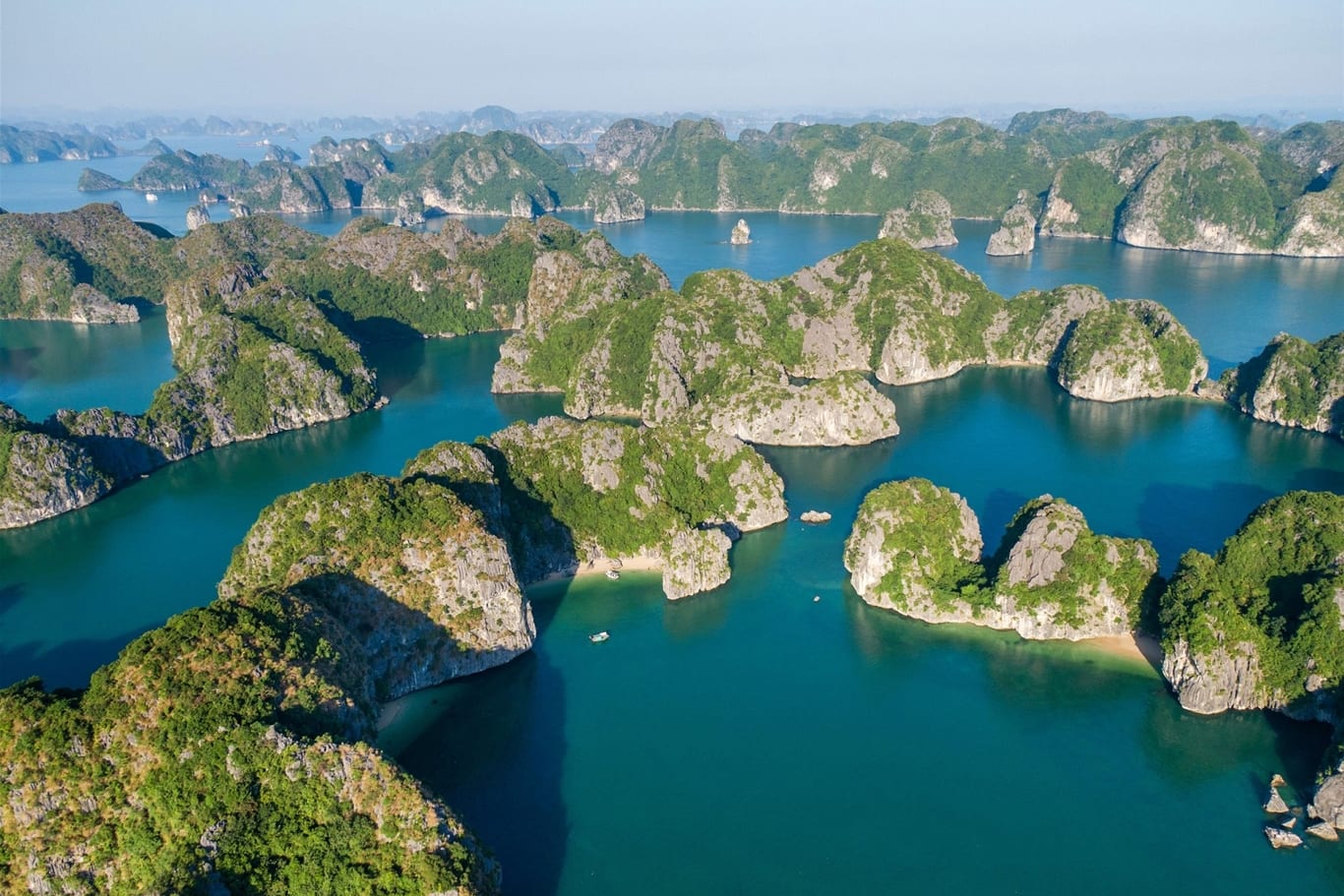
In addition to such breathtaking landscapes, the “isolated paradise” encompasses diverse and one-of-a-kind ecosystems: cave ecosystems, tidal ecosystems, coral ecosystems, soft bottom ecosystems, and saltwater lake ecosystems. Another highlight of Lan Ha Island is its historical geological values with an 18,000-year development of pyramidal karst topography.
Thanks to the unique features of nature and biodiversity, Lan Ha Bay was ranked as a National Park on the Sea by the Vietnamese Government in 1986. Besides, in 2004, the Bay was recognized by UNESCO as a World Biosphere Reserve and in 2012, was ranked as a special national scenic spot.
Do I need a visa to Vietnam?
Generally foreign tourists are required to apply for a visa to enter Vietnam (except for citizens of countries that are exempted from Vietnam visa).
Vietnam visa exemptions
Here is the list of countries whose citizens are allowed to travel to Vietnam without a visa for a short-term period (14-90 days):
- Up-to-14-day visa exemption: Brunei, Myanmar
- Up-to-15-day visa exemption: South Korea, Japan, Russia, Sweden, Denmark, Finland, Norway, United Kingdom, France, Germany, Spain, Italy, Belarus
- Up-to-21-day visa exemption: The Philippines
- Up-to-30-day visa exemption: Cambodia, Indonesia, Malaysia, Singapore, Thailand, Kyrgyzstan
- Up-to-90-day visa exemption: Chile
How to apply a visa to Vietnam
There are three main methods of Vietnam visa application that tourists can apply:
- In-person: at an Embassy or Consulate of Vietnam abroad
- Online: if you come from one of the eligible countries
- On Arrival: after getting an online Approval Letter before traveling
Vietnam’s e-Visa
Vietnam’s Electronic Visa (e-Visa) is issued by the Vietnam Immigration Department to foreigners entering the country. The e-Visa is valid for 30 days and single-entry only. It costs 25 USD for card payments and requires three full working days to process. As of July 2020, Vietnam’s e-Visa is available to citizens of 80 nations. Your e-Visa is valid for entry at 28 international checkpoints in Vietnam, including eight international airports.
The duration of processing a Vietnam visa
- For a Vietnam visa at an Embassy/Consulate: It depends on each specific Embassy/Consulate
- For a Vietnam e-Visa: About three working days
- For a Vietnam visa on arrival: Between 2-4 working days (sometimes more) for the Approval Letter
The validity of a Vietnam visa
- Single-entry visa: issued for 1 month or 3 months
- Multiple-entry visa: issued for 1 month, 3 months, 6 months, or 1 year
This travel guide is expected to support international tourists in planning and preparing for your first-time trip to Halong Bay Vietnam. Based on our recommendations, you can have a clear answer to your questions related to Halong Bay travel; from the weather, must-try activities, local cuisine to the popular ways of transfer between Hanoi and Halong, or choices of accommodation.







